Overcoming the Trade-Off between Methanol Rejection and Proton Conductivity via Facile Synthesis of Crosslinked Sulfonated PEEK Proton Exchange Membranes
Abstract
:1. Introduction
2. Materials and Methods
2.1. Materials
2.2. Membrane Synthesis
2.3. Material Characterization
- 1.
- FTIR spectra of the membrane films were obtained with an FTIR Spectrometer (Spectrum 100, PerkinElmer, Waltham, MA, USA) in ATR mode using a diamond crystal (scan number = 4, resolution = 4 cm−1).
- 2.
- The H-NMR spectrum was determined by dissolving 0.05 g sPEEK in 1 mL of deuterated DMSO. The H-NMR instrument (Bruker Avance III HD 400, Kontich, Belgium) was operated at 400 MHz. The degree of sulfonation was determined via the method of Arul Joseph Helen Therese et al. [31]:
- 3.
- X-ray photoelectron spectroscopy (XPS) was carried out on a Kratos Axis SUPRAX-ray photoelectron spectrometer equipped with a charge neutralizer and a magnetic focusing lens, using Al K monochromated radiation (1486.7 eV). The surface charging of these samples was neutralized using a flood gun. All the spectra were fitted using CasaXPS, with energy referencing the C 1s peak. The background was corrected using a Shirley-type function.
- 4.
- Scanning electron microscopy (SEM): To visualize the membrane structure and pore sizes, the membranes were analyzed using an SEM ULTRA (Zeiss). Membrane samples of approximately 1 cm2 were placed on an SEM holder and sputter coated with a gold layer of 1.5 to 2 nm (BALZERS UNION FL 9460 BALZERS SCD 030). A voltage of 5 kV was used to obtain an image of the membrane surface. To evaluate the cross-section of the membrane, the membranes were repeatedly dipped in deionized water and consecutively immersed in liquid nitrogen. At these low temperatures, the membranes became brittle and could be broken without deforming the cross-section. A gold coating was also applied to these samples before the SEM analysis [32].
2.4. Membrane Parameters
- 1.
- Ion exchange capacity: The dry mass of the membranes was measured on an analytical balance, and the sample was immersed in a 12 v% HCl solution for 48 h to protonate the sulfonic acid groups. The membrane samples and storage bottles were thoroughly washed with Milli-Q water before immersing the samples in a 1 M NaCl solution for 48 h. The protons in this NaCl solution were titrated with a 0.5 M NaOH solution using phenolphthalein as the indicator. The IEC was calculated using the following formula:in which , and are the concentration of NaOH (mmol/L), the volume of NaOH used during the titration (l) and the mass of the tested membrane sample (g), respectively.
- 2.
- Water and methanol uptake: The membrane samples were dried for 20 h at 55 °C, and the dry membrane mass was determined. Afterward, the membranes were soaked in pure water/methanol for 24 h. The membranes were taken out of the corresponding bath, excess liquid droplets were removed from the surface using a paper towel, and the mass of the membrane samples was determined. The uptake was calculated as follows:in which is the weight of the dry membrane sample (g), and and are the membrane mass (g) after being soaked for 24 h in water and methanol, respectively.
- 3.
- The cation/anion permeation of the membranes was determined following the same procedure as reported by Deboli et al. and Firganek et al. [33,34]. First, the membrane was immersed in a 0.1 M KCl solution for 24 h. To perform the experiment, the membrane (active area 19.63 cm2) was positioned in a two-compartment cell equipped with two saturated calomel electrodes. The donor compartment was filled with a 0.5 M KCl solution and the receiving cell with a 0.1 M KCl solution. The potential difference over the membrane was measured by means of the potentiostat Origaflex 01A from Origalys (France). The setup was left unattended until a stable value was reached (approximately 5 to 10 min). The cation/anion permeation was calculated, dividing the experimental potential difference () by the theoretical potential difference (), as can be seen in the following equation:
2.5. Performance Testing
- 1.
- Methanol diffusion coefficient and permeability: To measure the methanol crossover of the membrane, the membrane was first soaked in water for 24 h. Then, the membrane was placed in a two-compartment diffusion cell. Both compartments had the same dimensions, having a thickness of 1 cm and a circular cross-section with a diameter of 6 cm. The concentrate side was filled with a 2 M methanol solution and the dilute side with demineralized water. The setup was left unattended for 90 min to make the methanol diffuse through the membrane. The compartments were emptied in separate beakers and the solutions were intensely mixed before taking three samples of 20 µL. It is important to note that the mixing of the solution is crucial since methanol–water mixtures can have microscopic configurational inhomogeneities [37]. The methanol concentration of the samples was analyzed via GC-FID (TurboMatrix HS 40, PerkinElmer), with helium as the carrier gas. The methanol diffusion coefficient [38] and the methanol permeability are calculated as follows:, and are the average concentration changes in the concentrate and dilute compartment (mol/L), time of the experiment (min) and the methanol concentration of the concentrate compartment at the start (mol/L), respectively. VB, L and A represent, respectively, the volume in the dilute compartment (cm3) (which is similar to the concentrate compartment), the thickness of the membrane (cm) and the surface area of the membrane (cm2). The diffusion coefficient D describes the diffusion of methanol through the membrane, normalized by membrane surface area and by membrane thickness. Therefore, this parameter gives insight into the performance of the membrane material since the thickness of the membrane does not influence this parameter. The permeability parameter P describes the methanol crossover through the complete membrane. The membrane thickness does have an influence on this parameter; therefore, the methanol permeability represents a more general membrane performance.
- 2.
- Proton resistance: AC impedance spectroscopy with a frequency range from 200 kHz to 1 Hz and an oscillating voltage between −10 and 10 mV (Biologic Sp-150 instrument) was used to determine the proton resistance of the membranes. Before performing the experiment, the membrane was soaked in a 1 M H2SO4 solution for 24 h. The membrane (active area = 1 cm2) was put in a two-compartment cell sandwiched between two platinum electrodes. During the experiment, a 1 M H2SO4 solution was pumped through both compartments at a flow rate of 49 mL/min. The blank measurement was performed following the same procedure without the membrane. The resistance value was derived from the intersect at high frequencies on a complex impedance plane with the Re(Z) axis. The proton resistance normalized by thickness was obtained by dividing that resistance value by the membrane thickness.
3. Results
3.1. Membrane Synthesis
3.2. Membrane Characterization
3.3. Membrane Parameters
3.4. Performance Testing: Proton Resistance/Methanol Diffusivity
4. Conclusions
Supplementary Materials
Author Contributions
Funding
Data Availability Statement
Acknowledgments
Conflicts of Interest
References
- Omer, A.M. Energy, environment and sustainable development. Renew. Sustain. Energy Rev. 2008, 12, 2265–2300. [Google Scholar] [CrossRef]
- Kim, Y.S.; Pivovar, B.S. Polymer Electrolyte Membranes for Direct Methanol Fuel Cells. Adv. Fuel Cells 2007, 1, 187–234. [Google Scholar] [CrossRef]
- Neburchilov, V.; Martin, J.; Wang, H.; Zhang, J. A review of polymer electrolyte membranes for direct methanol fuel cells. J. Power Sources 2007, 169, 221–238. [Google Scholar] [CrossRef]
- Parekh, A. Recent developments of proton exchange membranes for PEMFC: A review. Front. Energy Res. 2022, 10, 956132. [Google Scholar] [CrossRef]
- Okonkwo, P.C.; Belgacem, I.B.; Emori, W.; Uzoma, P.C. Nafion degradation mechanisms in proton exchange membrane fuel cell (PEMFC) system: A review. Int. J. Hydrogen Energy 2021, 46, 27956–27973. [Google Scholar] [CrossRef]
- Chabi, S.; Papadantonakis, K.M.; Lewis, N.S.; Freund, M.S. Membranes for artificial photosynthesis. Energy Environ. Sci. 2017, 10, 1320–1338. [Google Scholar] [CrossRef]
- Mauritz, K.A.; Moore, R.B. State of Understanding of Nafion. Chem. Rev. 2004, 104, 4535–4586. [Google Scholar] [CrossRef] [PubMed]
- Karimi, M.B.; Mohammadi, F.; Hooshyari, K. Recent approaches to improve Nafion performance for fuel cell applications: A review. Int. J. Hydrogen Energy 2019, 44, 28919–28938. [Google Scholar] [CrossRef]
- Hickner, M.A.; Ghassemi, H.; Kim, Y.S.; Einsla, B.R.; McGrath, J.E. Alternative Polymer Systems for Proton Exchange Membranes (PEMs). Chem. Rev. 2004, 104, 4587–4612. [Google Scholar] [CrossRef]
- Wang, R.; Zhang, W.; He, G.; Gao, P. Controlling fuel crossover and hydration in ultra-thin proton exchange membrane-based fuel cells using Pt-nanosheet catalysts. J. Mater. Chem. A 2014, 2, 16416–16423. [Google Scholar] [CrossRef]
- Dicks, A.L. PEM Fuel Cells. In Comprehensive Renewable Energy; Elsevier: Amsterdam, The Netherlands, 2012; pp. 203–245. [Google Scholar] [CrossRef]
- Grot, W. Manufacture. In Fluorinated Ionomers; Elsevier: Amsterdam, The Netherlands, 2011; pp. 11–48. [Google Scholar] [CrossRef]
- Feng, M.; Qu, R.; Wei, Z.; Wang, L.; Sun, P.; Wang, Z. Characterization of the thermolysis products of Nafion membrane: A potential source of perfluorinated compounds in the environment. Sci. Rep. 2015, 5, 9859. [Google Scholar] [CrossRef] [PubMed]
- Chen, H.; Yao, Y.; Zhao, Z.; Wang, Y.; Wang, Q.; Ren, C.; Wang, B.; Sun, H.; Alder, A.C. Multimedia Distribution and Transfer of Per- and Polyfluoroalkyl Substances (PFASs) Surrounding Two Fluorochemical Manufacturing Facilities in Fuxin, China. Environ. Sci. Technol. 2018, 52, 8263–8271. [Google Scholar] [CrossRef] [PubMed]
- Zhou, J.; Baumann, K.; Surratt, J.D.; Turpin, B.J. Legacy and emerging airborne per- and polyfluoroalkyl substances (PFAS) collected on PM2.5 filters in close proximity to a fluoropolymer manufacturing facility. Environ. Sci. Process Impacts 2022, 24, 2272–2283. [Google Scholar] [CrossRef] [PubMed]
- Depuydt, S.; Van der Bruggen, B. Green Synthesis of Cation Exchange Membranes: A Review. Membranes 2024, 14, 23. [Google Scholar] [CrossRef] [PubMed]
- Zaidi, S.M.J.; Mikhailenko, S.D.; Robertson, G.P.; Guiver, M.D.; Kaliaguine, S. Proton conducting composite membranes from polyether ether ketone and heteropolyacids for fuel cell applications. J. Memb. Sci. 2000, 173, 17–34. [Google Scholar] [CrossRef]
- Zhao, C.; He, D.; Li, Y.; Xiang, J.; Li, P.; Sue, H.-J. High-performance proton exchange membranes for direct methanol fuel cells based on a SPEEK/polybenzoxazine crosslinked structure. RSC Adv. 2015, 5, 47284–47293. [Google Scholar] [CrossRef]
- Zhao, C.; He, D.; Yang, Q.; Li, Y.; Yue, J. Preparation and properties of semi-IPN proton exchange membranes based on SPEEK and cross-linked PSt-DVB for direct methanol fuel cells. High. Perform. Polym. 2017, 29, 1110–1117. [Google Scholar] [CrossRef]
- Ramly, N.N.B.; Ali, A.M.M.B. The preparation and characterization of sulfonated poly (ether ether ketone) and Cellulose Acetate (SPEEK-CA) membrane in proton exchange membrane fuel cells (PEMFCs) by UV-crosslink technique. In Proceedings of the 2012 IEEE Colloquium on Humanities, Science and Engineering (CHUSER), Kota Kinabalu, Malaysia, 3–4 December 2012; pp. 637–641. [Google Scholar] [CrossRef]
- Li, W.; Jiang, J.; An, H.; Dong, S.; Yue, Z.; Qian, H.; Yang, H. Self-Cross-Linked Sulfonated Poly(ether ether ketone) with Pendant Sulfoalkoxy Groups for Proton Exchange Membrane Fuel Cells. ACS Appl. Energy Mater. 2021, 4, 2732–2740. [Google Scholar] [CrossRef]
- Zhong, S.; Cui, X.; Cai, H.; Fu, T.; Zhao, C.; Na, H. Crosslinked sulfonated poly(ether ether ketone) proton exchange membranes for direct methanol fuel cell applications. J. Power Sources 2007, 164, 65–72. [Google Scholar] [CrossRef]
- Wang, R.; Liu, S.; Wang, L.; Li, M.; Gao, C. Understanding of Nanophase Separation and Hydrophilic Morphology in Nafion and SPEEK Membranes: A Combined Experimental and Theoretical Studies. Nanomaterials 2019, 9, 869. [Google Scholar] [CrossRef]
- Xiao, T.; Wang, R.; Chang, Z.; Fang, Z.; Zhu, Z.; Xu, C. Electrolyte membranes for intermediate temperature proton exchange membrane fuel cell. Progress. Nat. Sci. Mater. Int. 2020, 30, 743–750. [Google Scholar] [CrossRef]
- Lan, Y.; Huang, Y.; Zhou, D.; Zhang, X.; Xia, L.; Dewil, R.; Van der Bruggen, B.; Zhao, Y. Internally Cross-Linked Polysulfone-Based Anion Exchange Membranes with pH Stability for Carboxylate Separation. ACS EST Water 2023, 3, 4183–4194. [Google Scholar] [CrossRef]
- Mirfarsi, S.H.; Parnian, M.J.; Rowshanzamir, S.; Kjeang, E. Current status of cross-linking and blending approaches for durability improvement of hydrocarbon-based fuel cell membranes. Int. J. Hydrogen Energy 2022, 47, 13460–13489. [Google Scholar] [CrossRef]
- Deboli, F.; Van der Bruggen, B.; Donten, M.L. A novel concept of hierarchical cation exchange membrane fabricated from commodity precursors through an easily scalable process. J. Membr. Sci. 2021, 636, 119594. [Google Scholar] [CrossRef]
- Samimi, F.; Rahimpour, M.R. Direct Methanol Fuel Cell. In Methanol; Elsevier: Amsterdam, The Netherlands, 2018; pp. 381–397. [Google Scholar] [CrossRef]
- Loh, X.X.; Sairam, M.; Bismarck, A.; Steinke, J.H.G.; Livingston, A.G.; Li, K. Crosslinked integrally skinned asymmetric polyaniline membranes for use in organic solvents. J. Membr. Sci. 2009, 326, 635–642. [Google Scholar] [CrossRef]
- Wang, K.Y.; Xiao, Y.; Chung, T.-S. Chemically modified polybenzimidazole nanofiltration membrane for the separation of electrolytes and cephalexin. Chem. Eng. Sci. 2006, 61, 5807–5817. [Google Scholar] [CrossRef]
- Therese, J.A.J.H.; Selvakumar, K.; Gayathri, R.; Prabhu, M.R.; Sivakumar, P. In situ polymerization of poly aniline—SPEEK-PMA-based proton exchange membrane for DMFC application. J. Thermoplast. Compos. Mater. 2021, 34, 221–237. [Google Scholar] [CrossRef]
- Li, W.; Molina-Fernández, C.; Estager, J.; Monbaliu, J.-C.M.; Debecker, D.P.; Luis, P. Supported ionic liquid membranes for the separation of methanol/dimethyl carbonate mixtures by pervaporation. J. Membr. Sci. 2020, 598, 117790. [Google Scholar] [CrossRef]
- Deboli, F.; Van der Bruggen, B.; Donten, M.L. A versatile chemistry platform for the fabrication of cost-effective hierarchical cation and anion exchange membranes. Desalination 2022, 535, 115794. [Google Scholar] [CrossRef]
- Firganek, D.; Donten, M.L.; Van der Bruggen, B. Impact of Formulation of Photocurable Precursor Mixtures on the Performance and Dimensional Stability of Hierarchical Cation Exchange Membranes. Ind. Eng. Chem. Res. 2023, 62, 15928–15939. [Google Scholar] [CrossRef]
- Pitzer, K.S.; Peiper, J.C. Activity coefficient of aqueous sodium bicarbonate. J. Phys. Chem. 1980, 84, 2396–2398. [Google Scholar] [CrossRef]
- Dash, D.; Kumar, S.; Mallika, C.; Mudali, U.K. New Data on Activity Coefficients of Potassium, Nitrate, and Chloride Ions in Aqueous Solutions of KNO3 and KCl by Ion Selective Electrodes. ISRN Chem. Eng. 2012, 2012, 730154. [Google Scholar] [CrossRef]
- Bakó, I.; Megyes, T.; Bálint, S.; Grósz, T.; Chihaia, V. Water–methanol mixtures: Topology of hydrogen bonded network. Phys. Chem. Chem. Phys. 2008, 10, 5004. [Google Scholar] [CrossRef] [PubMed]
- Zhong, S.; Cui, X.; Cai, H.; Fu, T.; Shao, K.; Na, H. Crosslinked SPEEK/AMPS blend membranes with high proton conductivity and low methanol diffusion coefficient for DMFC applications. J. Power Sources 2007, 168, 154–161. [Google Scholar] [CrossRef]
- Huang, R.Y.M.; Shao, P.; Burns, C.M.; Feng, X. Sulfonation of poly(ether ether ketone)(PEEK): Kinetic study and characterization. J. Appl. Polym. Sci. 2001, 82, 2651–2660. [Google Scholar] [CrossRef]
- Al Lafi, A.G. The sulfonation of poly(ether ether ketone) as investigated by two-dimensional FTIR correlation spectroscopy. J. Appl. Polym. Sci. 2015, 132. [Google Scholar] [CrossRef]
- Zhao, Y.; Wu, M.; Shen, P.; Uytterhoeven, C.; Mamrol, N.; Shen, J.; Gao, C.; Van der Bruggen, B. Composite anti-scaling membrane made of interpenetrating networks of nanofibers for selective separation of lithium. J. Membr. Sci. 2021, 618, 118668. [Google Scholar] [CrossRef]
- Zhao, Y.; Li, Y.; Zhu, J.; Lejarazu-Larrañaga, A.; Yuan, S.; Ortega, E.; Shen, J.; Gao, C.; Van der Bruggen, B. Thin and robust organic solvent cation exchange membranes for ion separation. J. Mater. Chem. A Mater. 2019, 7, 13903–13909. [Google Scholar] [CrossRef]
- Zhao, Y.; Qiu, Y.; Mai, Z.; Ortega, E.; Shen, J.; Gao, C.; Van der Bruggen, B. Symmetrically recombined nanofibers in a high-selectivity membrane for cation separation in high temperature and organic solvent. J. Mater. Chem. A Mater. 2019, 7, 20006–20012. [Google Scholar] [CrossRef]
- Zhu, Y.; Cao, Z.; Peng, Y.; Hu, L.; Guney, T.; Tang, B. Facile Surface Modification Method for Synergistically Enhancing the Biocompatibility and Bioactivity of Poly(ether ether ketone) That Induced Osteodifferentiation. ACS Appl. Mater. Interfaces 2019, 11, 27503–27511. [Google Scholar] [CrossRef]
- Chu, P.K.; Li, L. Characterization of amorphous and nanocrystalline carbon films. Mater. Chem. Phys. 2006, 96, 253–277. [Google Scholar] [CrossRef]
- Afroj, S.; Karim, N.; Wang, Z.; Tan, S.; He, P.; Holwill, M.; Ghazaryan, D.; Fernando, A.; Novoselov, K.S. Engineering Graphene Flakes for Wearable Textile Sensors via Highly Scalable and Ultrafast Yarn Dyeing Technique. ACS Nano 2019, 13, 3847–3857. [Google Scholar] [CrossRef] [PubMed]
- Collado, L.; Reynal, A.; Fresno, F.; Barawi, M.; Escudero, C.; Perez-Dieste, V.; Coronado, J.M.; Serrano, D.P.; Durrant, J.R.; de la Peña O’Shea, V.A. Unravelling the effect of charge dynamics at the plasmonic metal/semiconductor interface for CO2 photoreduction. Nat. Commun. 2018, 9, 4986. [Google Scholar] [CrossRef] [PubMed]
- Xi, J.; Wu, Z.; Qiu, X.; Chen, L. Nafion/SiO2 hybrid membrane for vanadium redox flow battery. J. Power Sources 2007, 166, 531–536. [Google Scholar] [CrossRef]
- Meng, X.; Song, K.; Lv, Y.; Cong, C.; Ye, H.; Dong, Y.; Zhou, Q. SPEEK proton exchange membrane with enhanced proton conductivity stability from phosphotungstic acid-encapsulated silica nanorods. Mater. Chem. Phys. 2021, 272, 125045. [Google Scholar] [CrossRef]
- Napoli, L.; Franco, J.; Fasoli, H.; Sanguinetti, A. Conductivity of Nafion® 117 membrane used in polymer electrolyte fuel cells. Int. J. Hydrogen Energy 2014, 39, 8656–8660. [Google Scholar] [CrossRef]
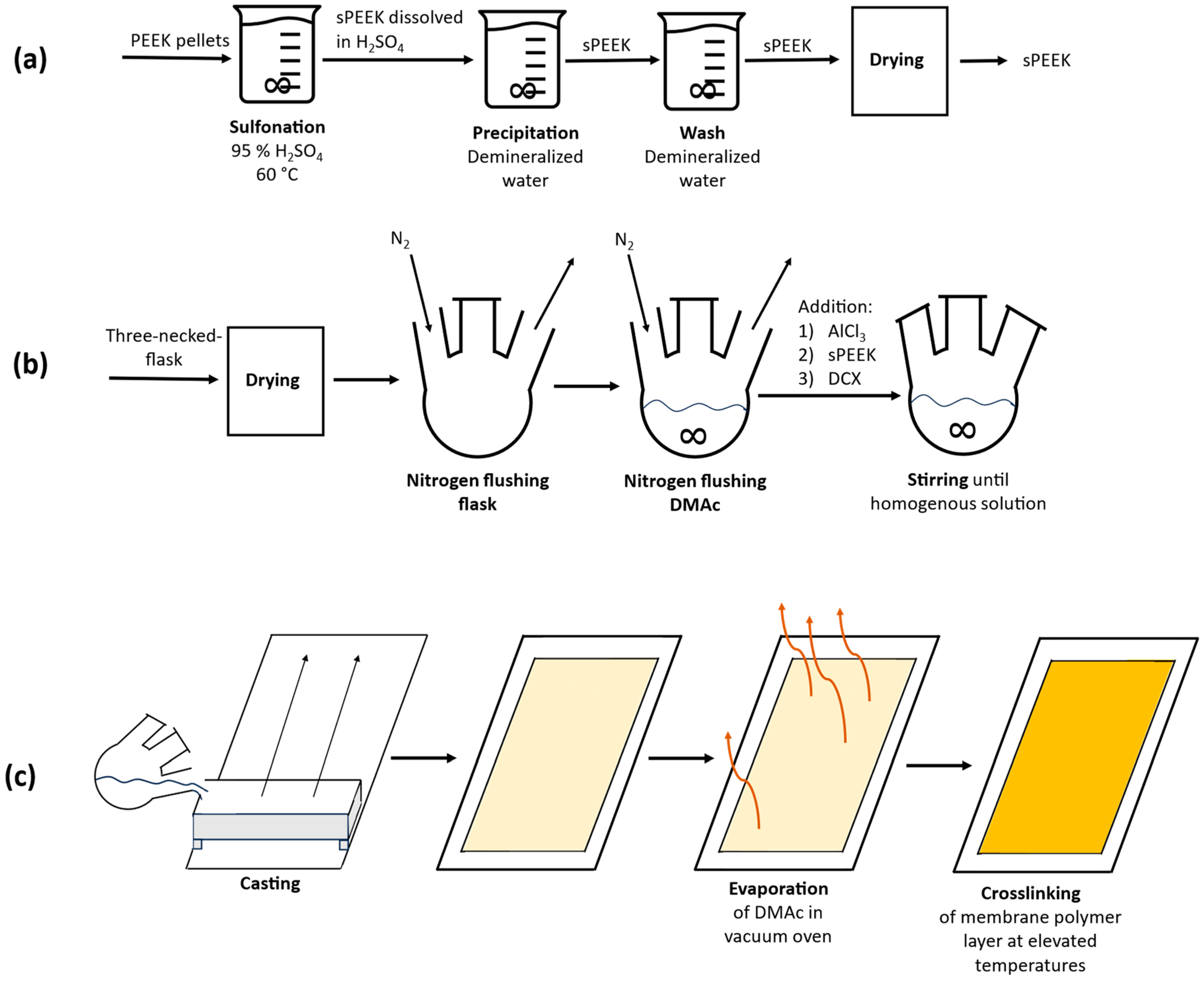

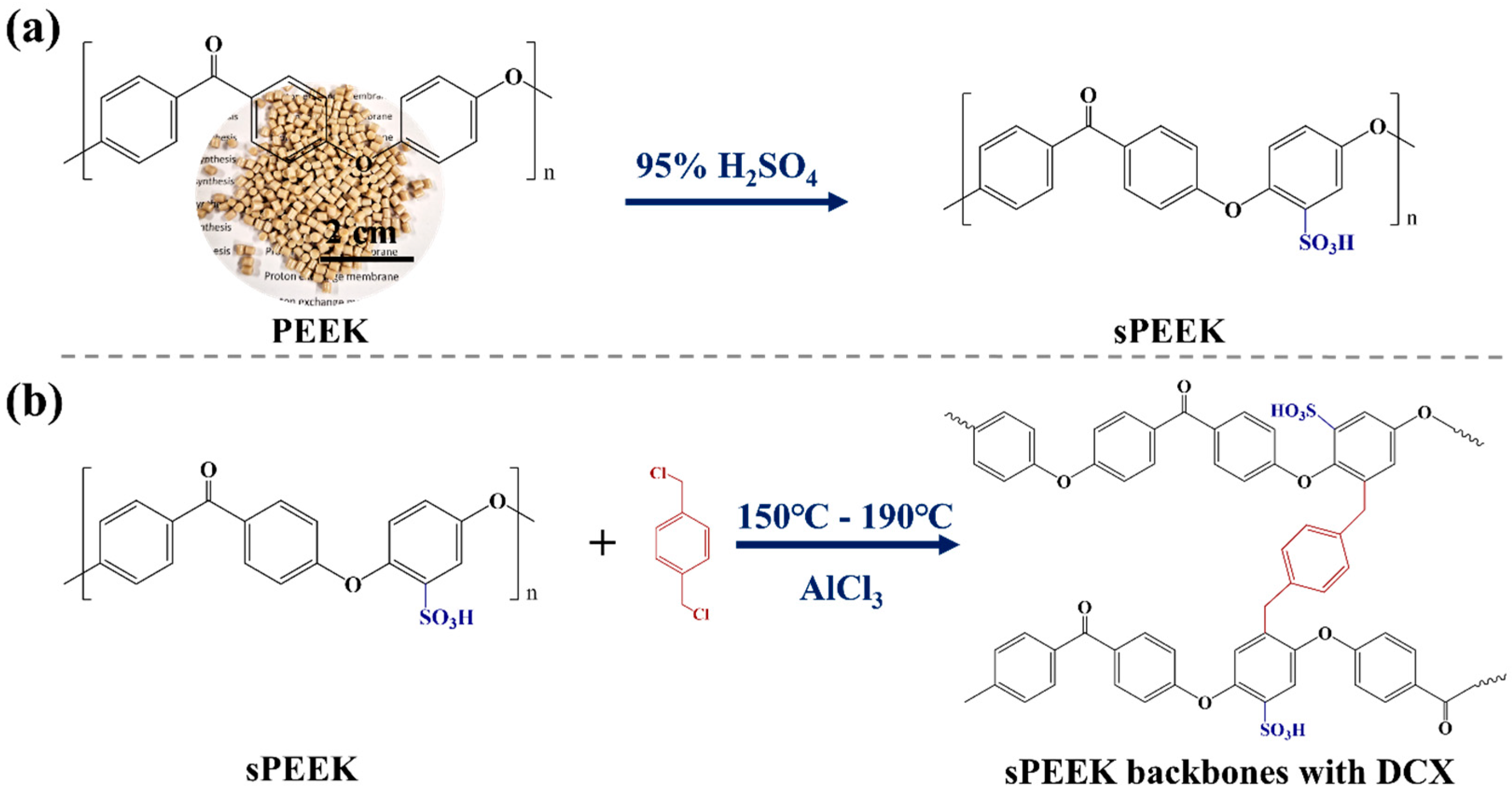

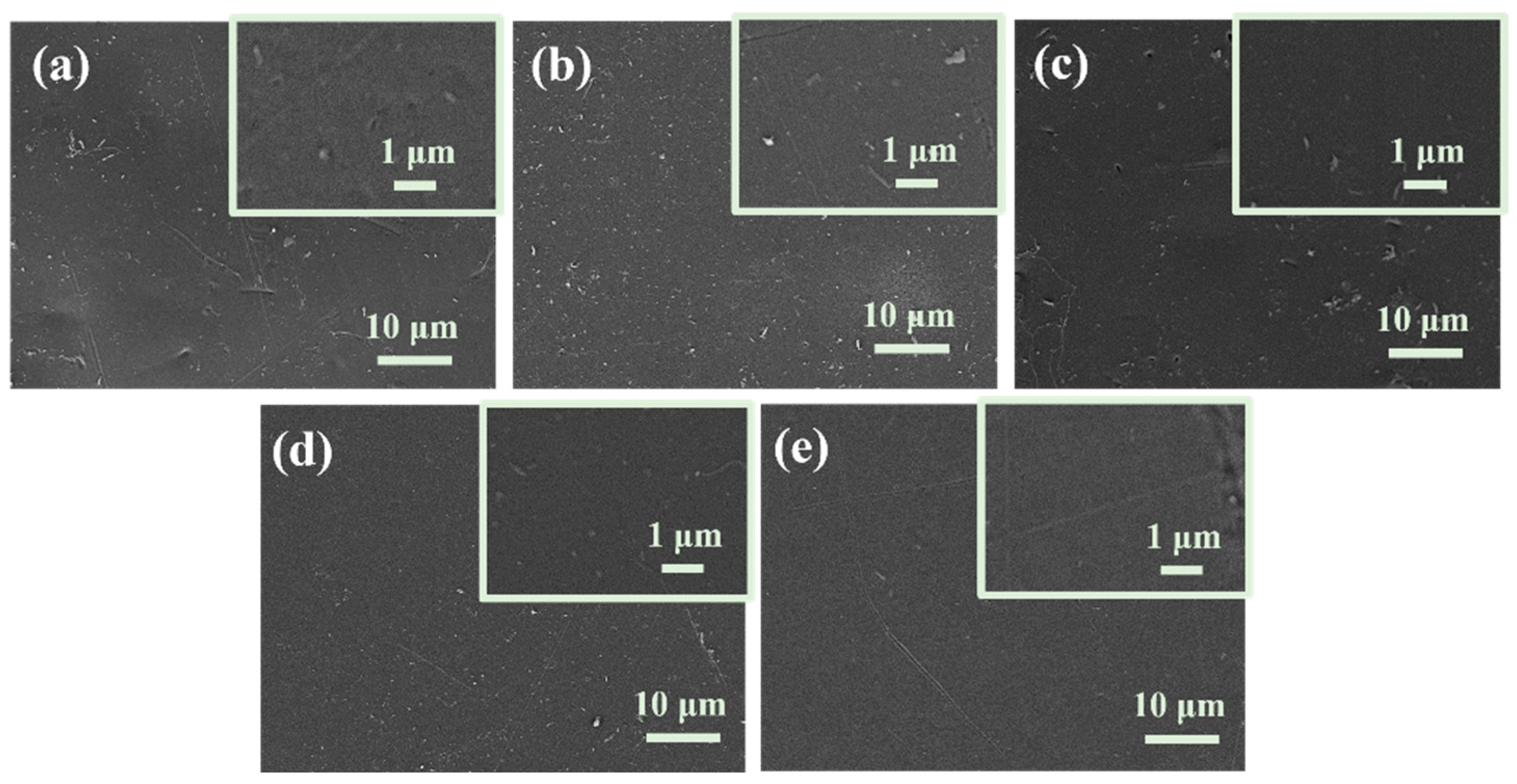
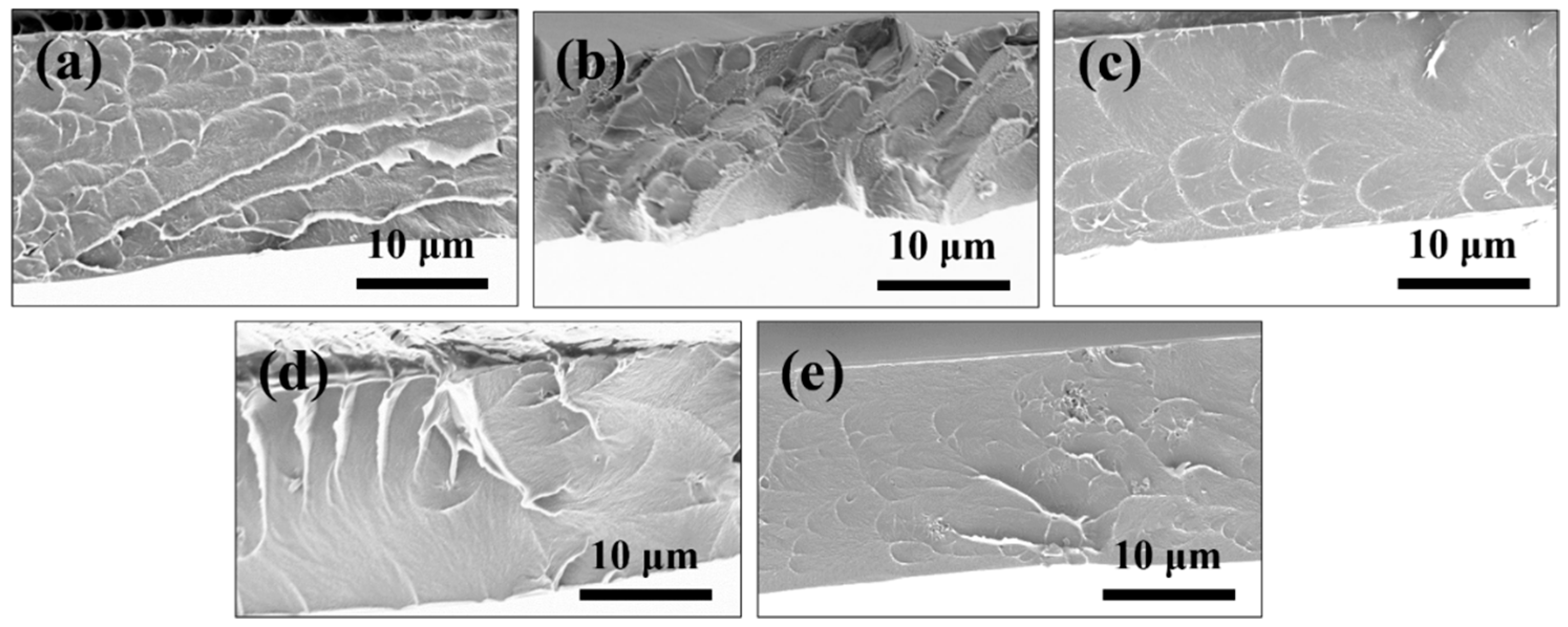
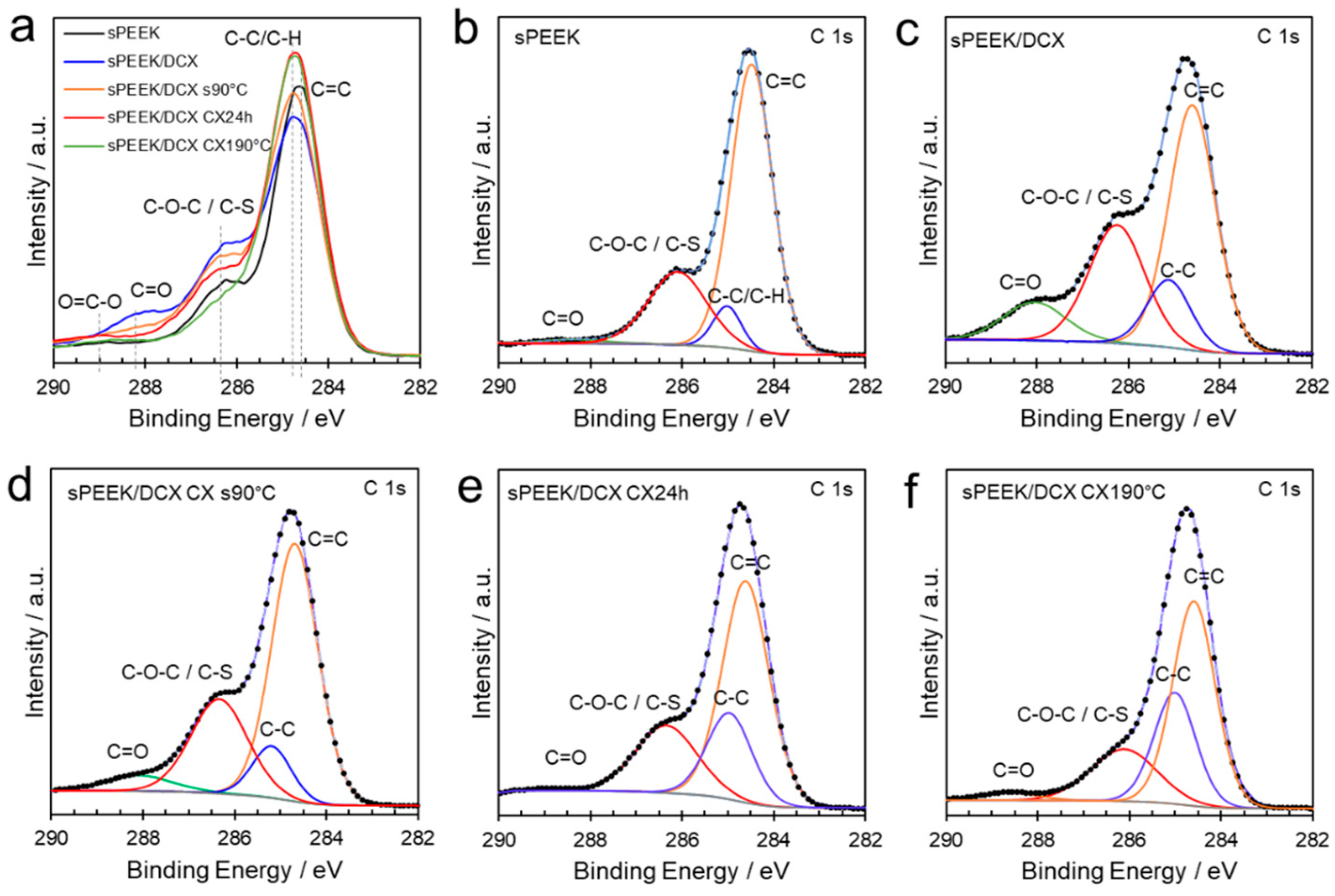

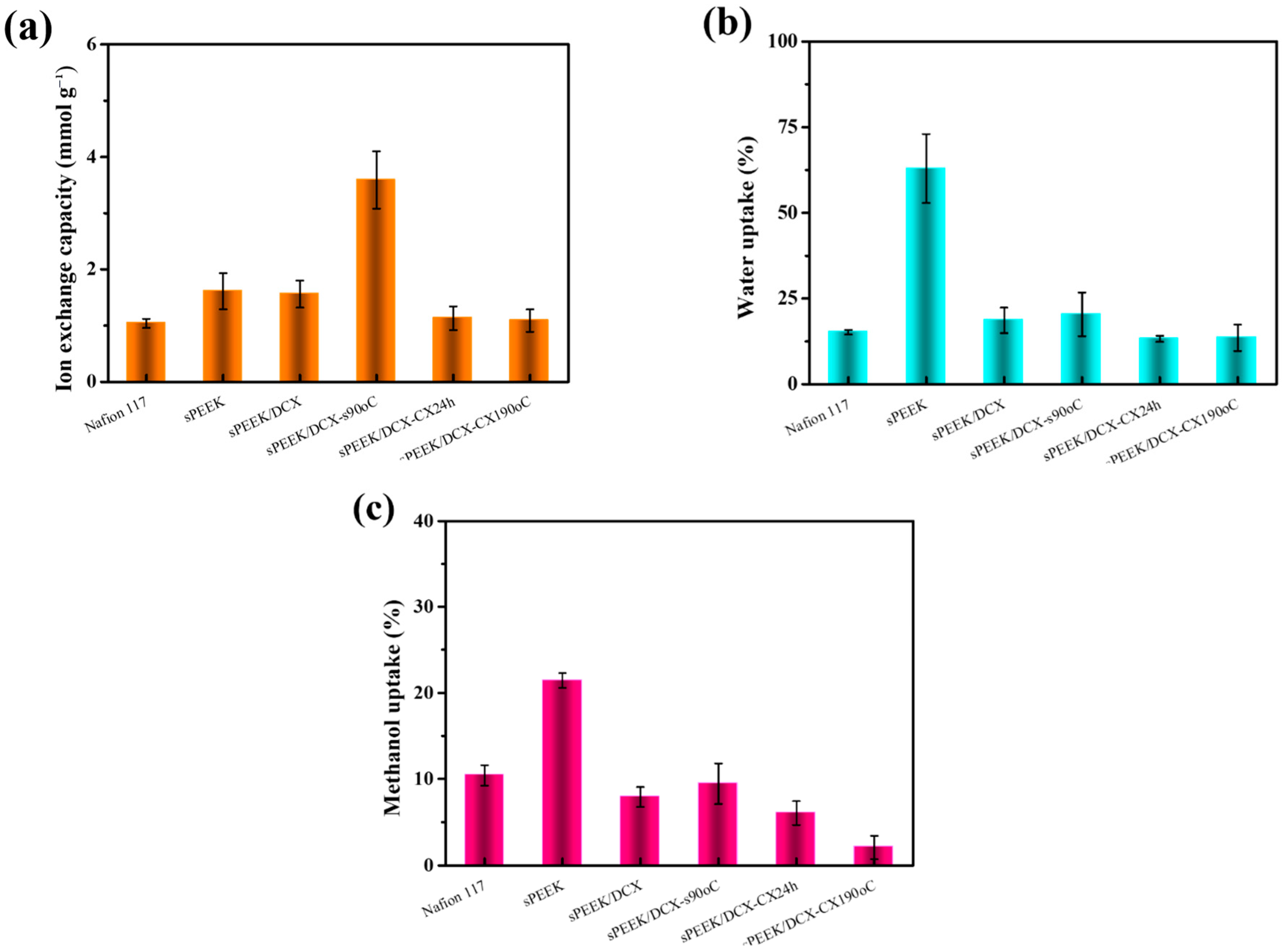
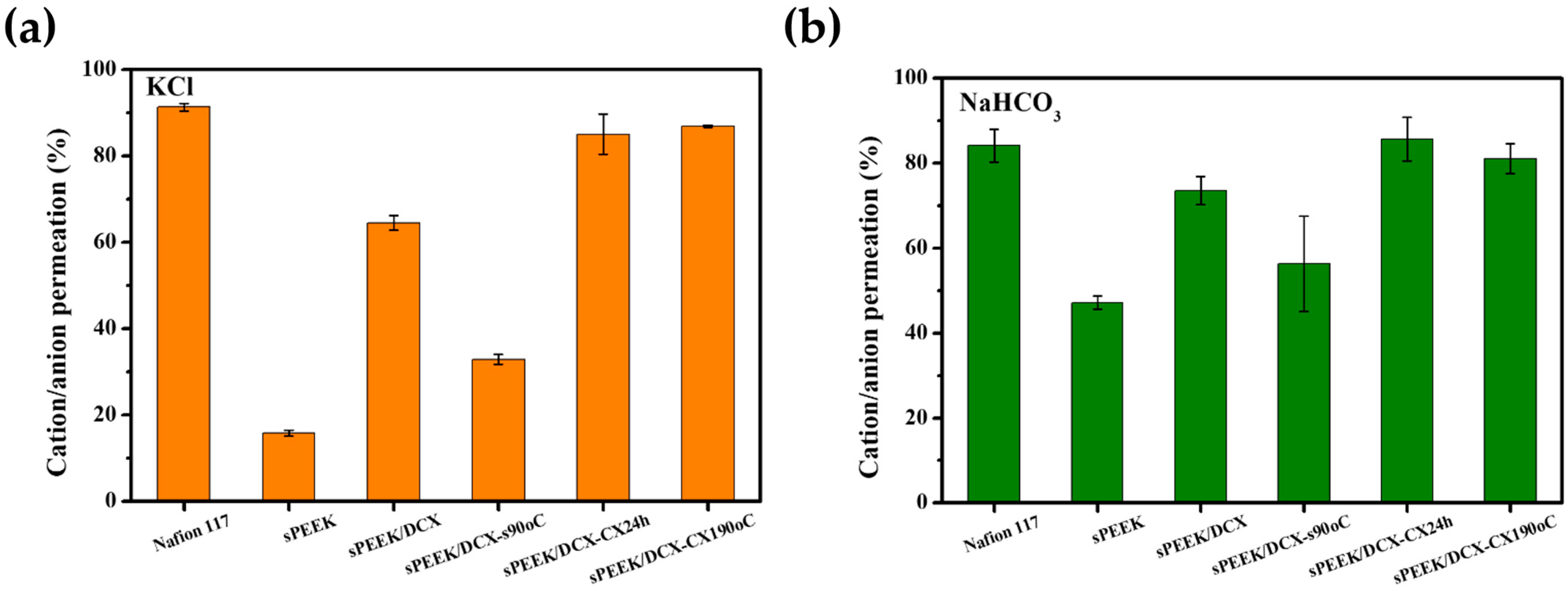
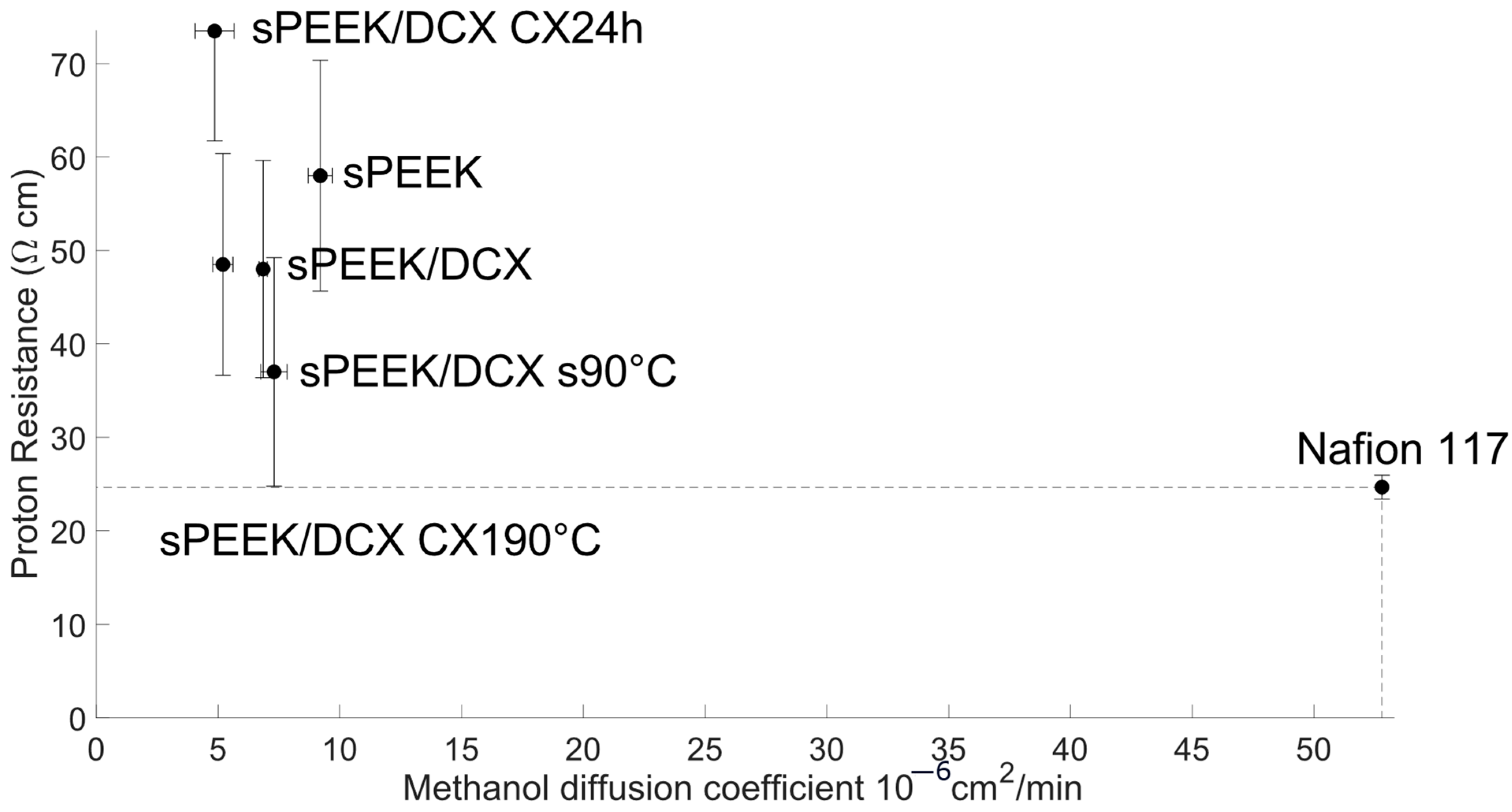
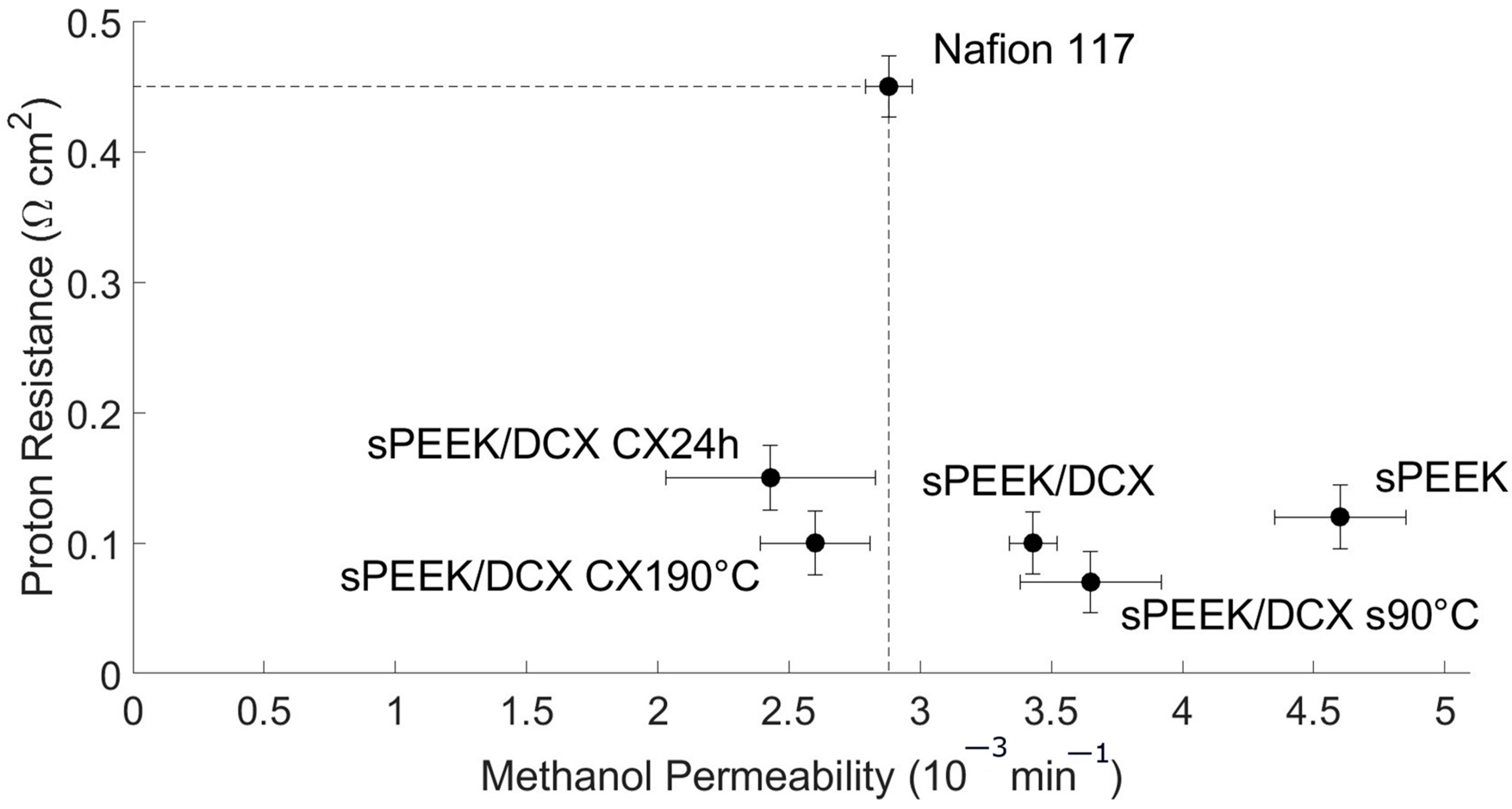
| Membrane | Sulfonation Temperature (°C) | Sulfonation Time (h) | Crosslinking Temperature (°C) | Crosslinking Time (h) |
|---|---|---|---|---|
| sPEEK | 60 | 24 | / | / |
| sPEEK/DCX | 60 | 24 | 140 | 15 |
| sPEEK/DCX-s90°C | 90 | 24 | 140 | 15 |
| sPEEK/DCX-CX24h | 60 | 24 | 140 | 24 |
| sPEEK/DCX-CX190°C | 60 | 24 | 190 | 15 |
| Membrane | C 1s, Binding Energies (eV) | ||
|---|---|---|---|
| 284.5 C=C | 284.9 C-C | Ratio C=C/C-C | |
| sPEEK | 67.76 | 6.81 | 9.95 |
| sPEEK/DCX | 48.11 | 12.39 | 3.88 |
| sPEEK/DCX-s90°C | 58.60 | 9.88 | 5.93 |
| sPEEK/DCX-CX24h | 55.82 | 20.94 | 2.66 |
| sPEEK/DCX-CX190°C | 50.57 | 27.20 | 1.86 |
Disclaimer/Publisher’s Note: The statements, opinions and data contained in all publications are solely those of the individual author(s) and contributor(s) and not of MDPI and/or the editor(s). MDPI and/or the editor(s) disclaim responsibility for any injury to people or property resulting from any ideas, methods, instructions or products referred to in the content. |
© 2024 by the authors. Licensee MDPI, Basel, Switzerland. This article is an open access article distributed under the terms and conditions of the Creative Commons Attribution (CC BY) license (https://creativecommons.org/licenses/by/4.0/).
Share and Cite
Depuydt, S.; Traub, L.; Van Eygen, G.; Kumar, S.; Held, G.; Van der Bruggen, B. Overcoming the Trade-Off between Methanol Rejection and Proton Conductivity via Facile Synthesis of Crosslinked Sulfonated PEEK Proton Exchange Membranes. Appl. Sci. 2024, 14, 3089. https://doi.org/10.3390/app14073089
Depuydt S, Traub L, Van Eygen G, Kumar S, Held G, Van der Bruggen B. Overcoming the Trade-Off between Methanol Rejection and Proton Conductivity via Facile Synthesis of Crosslinked Sulfonated PEEK Proton Exchange Membranes. Applied Sciences. 2024; 14(7):3089. https://doi.org/10.3390/app14073089
Chicago/Turabian StyleDepuydt, Stef, Lucy Traub, Gilles Van Eygen, Santosh Kumar, Georg Held, and Bart Van der Bruggen. 2024. "Overcoming the Trade-Off between Methanol Rejection and Proton Conductivity via Facile Synthesis of Crosslinked Sulfonated PEEK Proton Exchange Membranes" Applied Sciences 14, no. 7: 3089. https://doi.org/10.3390/app14073089
APA StyleDepuydt, S., Traub, L., Van Eygen, G., Kumar, S., Held, G., & Van der Bruggen, B. (2024). Overcoming the Trade-Off between Methanol Rejection and Proton Conductivity via Facile Synthesis of Crosslinked Sulfonated PEEK Proton Exchange Membranes. Applied Sciences, 14(7), 3089. https://doi.org/10.3390/app14073089






